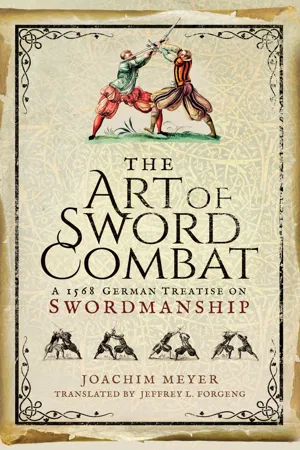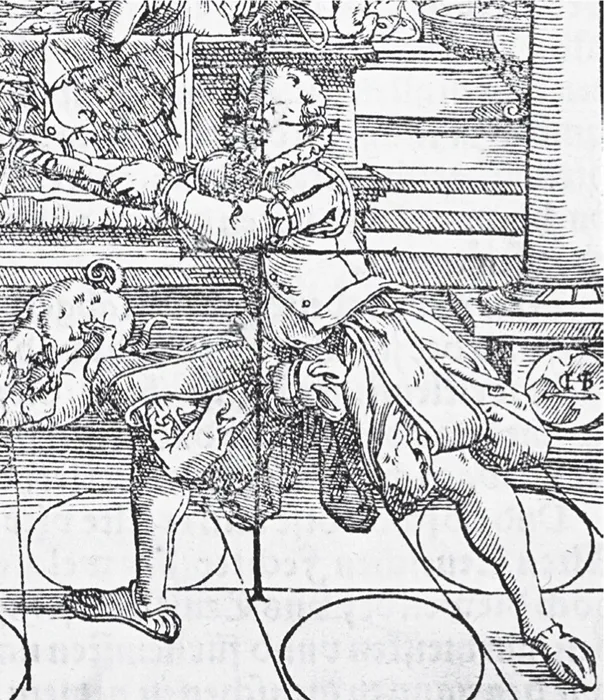
- 144 pages
- English
- ePUB (mobile friendly)
- Available on iOS & Android
eBook - ePub
About this book
This sixteenth-century German guide to sword fighting and combat training is a crucial source for understanding medieval swordplay techniques.
Following his translation of Joachim Meyer's The Art of Combat, Jeffrey L. Forgeng was alerted to an earlier version of Meyer's text, discovered in Lund University Library in Sweden. The manuscript, produced in Strasbourg around 1568, is illustrated with thirty watercolor images and seven ink diagrams. The text covers combat with the longsword (hand-and-a-half sword), dusack (a one-handed practice weapon comparable to a sabre), and rapier.
The manuscript's theoretical discussion of guards sheds significant light on this key feature of the historical practice, not just in relation to Meyer but in relation to medieval combat systems in general. The Art of Sword Combat also offers an extensive repertoire of training drills for both the dusack and the rapier, a feature largely lacking in treatises of the period and critical to modern reconstructions of the practice. Forgeng's translation also includes a biography of Meyer, much of which has only recently come to light, as well as technical terminology and other essential information for understanding and contextualizing the work.
Following his translation of Joachim Meyer's The Art of Combat, Jeffrey L. Forgeng was alerted to an earlier version of Meyer's text, discovered in Lund University Library in Sweden. The manuscript, produced in Strasbourg around 1568, is illustrated with thirty watercolor images and seven ink diagrams. The text covers combat with the longsword (hand-and-a-half sword), dusack (a one-handed practice weapon comparable to a sabre), and rapier.
The manuscript's theoretical discussion of guards sheds significant light on this key feature of the historical practice, not just in relation to Meyer but in relation to medieval combat systems in general. The Art of Sword Combat also offers an extensive repertoire of training drills for both the dusack and the rapier, a feature largely lacking in treatises of the period and critical to modern reconstructions of the practice. Forgeng's translation also includes a biography of Meyer, much of which has only recently come to light, as well as technical terminology and other essential information for understanding and contextualizing the work.
Frequently asked questions
Yes, you can cancel anytime from the Subscription tab in your account settings on the Perlego website. Your subscription will stay active until the end of your current billing period. Learn how to cancel your subscription.
At the moment all of our mobile-responsive ePub books are available to download via the app. Most of our PDFs are also available to download and we're working on making the final remaining ones downloadable now. Learn more here.
Perlego offers two plans: Essential and Complete
- Essential is ideal for learners and professionals who enjoy exploring a wide range of subjects. Access the Essential Library with 800,000+ trusted titles and best-sellers across business, personal growth, and the humanities. Includes unlimited reading time and Standard Read Aloud voice.
- Complete: Perfect for advanced learners and researchers needing full, unrestricted access. Unlock 1.4M+ books across hundreds of subjects, including academic and specialized titles. The Complete Plan also includes advanced features like Premium Read Aloud and Research Assistant.
We are an online textbook subscription service, where you can get access to an entire online library for less than the price of a single book per month. With over 1 million books across 1000+ topics, we’ve got you covered! Learn more here.
Look out for the read-aloud symbol on your next book to see if you can listen to it. The read-aloud tool reads text aloud for you, highlighting the text as it is being read. You can pause it, speed it up and slow it down. Learn more here.
Yes! You can use the Perlego app on both iOS or Android devices to read anytime, anywhere — even offline. Perfect for commutes or when you’re on the go.
Please note we cannot support devices running on iOS 13 and Android 7 or earlier. Learn more about using the app.
Please note we cannot support devices running on iOS 13 and Android 7 or earlier. Learn more about using the app.
Yes, you can access The Art of Sword Combat by Joachim Meyer in PDF and/or ePUB format, as well as other popular books in History & Early Modern History. We have over one million books available in our catalogue for you to explore.
Information
Joachim Meyer’s
Art of Sword Combat
<2r>

<2v–3r blank; 3v>

<4r, A-hand begins>
[Preface]
To the well-born lord, Lord Otto Count von Solms, lord of Münzenberg and Sonnenwalde etc., my gracious lord:
Well-born gracious lord, may my humble willing service be at all time present to your Grace. Gracious lord, ancient authors diligently praised and extolled the chivalric liberal art of combat in their books, instilling and earnestly commending it for princes and lords, and with good reason, particularly since we read in credible sources that it was the basis for most chivalric duelling and excellent deeds. For not only do Greek and Roman historians show what virility arose from it through excellent courage, and what glory has been attained through it in the highest leadership and supervision of warfare, but also daily experience demonstrates that whoever practises and diligently studies knightly sports and combat <4v> greatly outdoes those who have not practised, and skilfully outshines them in all things.
Therefore in our own times princes and lords greatly love and promote this art, no less than our ancestors; and your Grace has also earnestly embraced this virile art along with other liberal arts, and has summoned me to it as an honest combat-master to instruct your Grace in this art; and I have undertaken this in all humility with willing spirit. Since I have not only found a particular charm in this art, but also your Grace’s gracious and well-disposed will toward me, I have not spared in any way to humbly serve your Grace in this art.
Therefore I present your Grace this compiled Combat-Book with all its techniques, in the humble hope that your Grace will not only retain in mind the techniques that you have learned by reading about them, but also may learn from it many skills and useful <5r> techniques, no less than when your Grace had a daily combat-master with you. I therefore humbly pray your Grace will graciously receive this work of mine, however worthless and paltry it may be, as it flows from a heart humble and well-meaning toward your Grace in all possible service. I wish to be most diligent in this so that I may humbly serve and please your Grace.
May Almighty God grant your Grace long life in health and peace along with other benefits etc.
Your Grace’s humble and willing
Joachim Meyer
Combat-Master [Fechtmeister]
<5v blank; one folio apparently missing here; 6r>
Sword Combat
First, every attack combination in combat is divided into three stages which you should particularly observe in the sword, namely the attack, the followup, and the withdrawal or ending. Thus first, in the approach, the attack happens through the guards and cuts as they will follow hereafter; then in the second part and middle-work one follows up with the handwork and combinations of suitable cuts; and lastly comes the ending or withdrawal. And each of these will be diligently described and taught in orderly fashion hereafter in its place.
Secondly, you shall take heed of the Before and After, foible and forte. The Before is when you drive your opponent with your techniques so that he cannot achieve his intent, but confines himself to parrying, to defend against your techniques and counter and bar them, so that he leaves the Before to you.
The After is when you are rushed upon by your opponent as has just been described, then you shall instantly counter him quickly with suitable work, so that you impede him in his techniques, and so with your work deprive him of the Before, forcing him to parry you in the After. Thus there is a stubborn exchange with the Before and After, so that now one of you has it, now the other. Anyone who does not pay heed to it will never learn to do anything sure in combat.
<6v>
Division of the Sword into Foible and Forte
The sword is divided firstly into two parts, namely from the haft to the middle of the blade, which is the forte, then the middle to the tip is the foible.
The sword is further divided into four parts as the illustration below indicates. The nearer part, that is the haft, encompasses the work with the pommel along with the crossbar and grip. Next, the second part encompasses the work with slicing and pressing and whatever pertains to the forte. With the third part of the sword you should note the changing work of the foible and forte according to opportunity and will. The furthermost part pertains only to the foible with working to the opening.
Hard and Soft
Note that in the bindings of the sword, you will feel whether he has bound hard or soft with the cut, and whether he is strong or soft in holding against you. And you commonly have to guard more against soft than strong binds, as will be seen hereafter in the section on combat.
And so that the sword combat and techniques described hereafter may be more comprehensible, I will explain in my following epitome how I would have the terms understood according to the aforementioned order, namely beginning, middle, and end.

<7r>
Here Follows the Epitome of Sword Combat
The Four Chief Guards
‘From the Day’ [Von Dach]
Fool [Olber]
Ox [Ochs]
Plow [Pflug]
The Eight Secondary Guards
Longpoint [Langort]
Irongate [Eysenport]
Hanging Point [Hengetort]
Speaking-Window [Sprechfenster]
Key [Schlüssel]
Side Guard [Nebenhuot]
Crossed Guard [Schranckhut]
Wrath Guard [Zornleger]
The Five Master Cuts
Wrath Cut [Zornhaw]
Crooked Cut [Krumphaw]
Thwart Cut [Zwerchhaw]
Squinter Cut [Schylerhaw]
Scalper [Scheideler]
The Six Secret Cuts
Blind Cut [Blindthaw]
Rebound Cut [Brellhaw]
Short Cut [Kurtzhaw]
Wrist Cut [Knuchellhaw]
Clashing Cut [Glützhaw]
Winding Cut [Windthaw]
Handwork in the Sword
Binding [Anbinden]
Remaining [Bleiben]
Slicing [Schneiden]
Striking around [Umbschlagen]
Chasing [Nachreisen]
Snapping around [Umbschnappen]
Running off [Ablauffen]
Doubling [Doplieren]
Deceiving [Verfurenn]
Flitting [Verfligen]
Failing [Verfelen]
Circle [Zyrckel]
Loop [Rinde]
Winding [Winden]
Winding through [Durchwinden] Reversing [Verkeren]
Changing through [Durchwechslen] Overrunning [Überlauffen]
Setting off [Absetzen]
Slicing off [Abschneiden]
Pulling [Zucken]
Pressing hands [Hendttrucken]
Sliding [Verscheiben]
Hanging [Verhengen]
Blocking [Verstillen]
Barring [Sperren]
Wrenching [Aussreissen]
Gripping over [Übergreiffen]
Seizing the foible [Schwech fassen]
<7v>
Concerning the Four Openings and Division of the Combatant

Space has been left on this page for an illustration, de...
Table of contents
- Cover
- Title
- Copyright
- Contents
- Acknowledgements
- Introduction
- Joachim Meyer’s Art of Sword Combat
- Glossary
- German–English Word List
- Appendices
- Bibliography
- Plate section